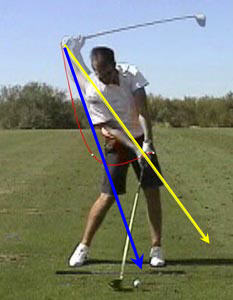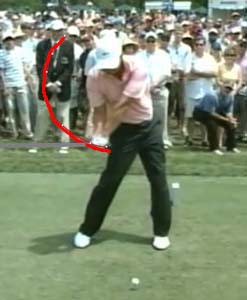10-23-0. GENERAL Power Package Delivery Paths are classified on the basis of three possible TYPES of paths the Hands can take toward impact. This results in five definable Paths. These Paths are actually the paths taken by the Hands --- NOT the Clubhead. (See 2-J-3.) The five Downstroke Paths are valid for equivalent Backstroke shifts, also.So, there are essentially 3 types of paths (Straight Line, Angled Line, and Circle) which results in 5 definable paths, which means that Mr. Kelley has 2 types of Straight Line Paths, 2 types of Angled Paths (which will be described below) and of course the Circle Delivery Paths, making 5 paths total. And it’s important to note that we are talking about the path the hands take, not the clubhead.
10-23-A. STRAIGHT LINE This pattern holds the Hands on a Delivery Path that is a Straight Line leading from the Top-of-the-line hand position directly at and through the Aiming Point (2-J-3) when there is no plane shift.Jeff Mann’s picture of Aaron Baddeley’s hand motion shows it best:
 The red line show the direction Aaron's hands actually went in from the top of the swing into impact. For the first 3/4's of the red line, his hands pretty much go in a straight line. The yellow line describes the Aiming Point for shorter clubs, like an 8-iron. The Aiming Point is where the golfer 'aims' the hands to 'thrust' into the ground (http://3jack.blogspot.com/2009/03/look-at-aiming-point-concept-6-e-2.html). Some golfers will feel like their #3 pressure point (the first joint or the 'base' joint of the right index finger) will go in a straight line right at the aiming point where it will be thrusted into the ground.
The red line show the direction Aaron's hands actually went in from the top of the swing into impact. For the first 3/4's of the red line, his hands pretty much go in a straight line. The yellow line describes the Aiming Point for shorter clubs, like an 8-iron. The Aiming Point is where the golfer 'aims' the hands to 'thrust' into the ground (http://3jack.blogspot.com/2009/03/look-at-aiming-point-concept-6-e-2.html). Some golfers will feel like their #3 pressure point (the first joint or the 'base' joint of the right index finger) will go in a straight line right at the aiming point where it will be thrusted into the ground.Mr. Kelley is NOT saying that golfers who use a straight line delivery path do not shift planes. But what he's saying the hands go from the top of the swing to the aiming point in a straight line and when they reach the aiming point, that's when there is no shift because essentially any shift in planes would have been completed already.
10-23-B. ANGLED LINE This pattern is used with the Plane Angle Variations that include a shift to (or back to) the Elbow Plane during the Downstroke (10-7). From the Top-of-the-Straight-Line hand position the Hands take a nearly vertical path to the Plane of the Elbow Plane angle before they start their drive directly at and through the Aiming Point (2-J-3).Jeff Mann's picture of Hogan's downswing depicts the Angled Line approach pretty well.

See how in the 4th frame there's an angle between lines 1 and 2? That's sort of what the angle line delivery path looks like.
But, it requires the golfer to have the downswing coming down on the elbow plane. My swing is a single shift swing which goes from the elbow plane to the turned shoulder plane in the backswing, but stays on the turned shoulder plane on the downswing. Because of that, I do not believe I could operate on an angled line hands delivery path.
10-23-C TOP ARC AND STRAIGHT LINE This pattern takes the hands beyond the Top-of-the-Line point, up and back along an Arc that is retraced when the Hands return to the Top-of-the-Line point. This 'retracing' is ideal for longitudinal acceleration with 10-19-C.Top Arc is referring to the hands being at the top of the arc at the top of the swing. Sort of like having the hands wayyyy 'back.' Almost in back of the head. Like Snead at the top.

Compared to Hogan's hands at the top of the swing:
 From there, the hands get back on the straight line delivery path. I don't *think* Snead actually has a Top Arc and Straight Line path, which I will explain later. But it does appear that Fred Couples is a Top Arc and Straight Line path golfer. Longitude means moving east and west. Longitudinal Acceleration is associated with 'drag loading' which is a 'swinging' procedure. Couples utilizes a 'swinging' method.
From there, the hands get back on the straight line delivery path. I don't *think* Snead actually has a Top Arc and Straight Line path, which I will explain later. But it does appear that Fred Couples is a Top Arc and Straight Line path golfer. Longitude means moving east and west. Longitudinal Acceleration is associated with 'drag loading' which is a 'swinging' procedure. Couples utilizes a 'swinging' method.10-23-D TOP ARC AND ANGLED LINE This path is the same as 'C' above except that from the Top-of-the-Line position the Hands take the Angled Line Delivery Path ('B' above).So same Top Arc approach, but with an angled line delivery instead of a straight line delivery. I believe Snead was Top Arc and Angled Line. This requires the golfer to be on the elbow plane in the downswing as well.
10-23-E. CIRCLE Here, no straight Line Path is attempted. The Hands swing along on a continuation of the Top Arc formed below or above the Top-of-the-Line because any portion of the Path can be the Top Arc regardless of having reached a Top-of-the-Line position or not. So --- from any Assembly Point the Path to the ball in this case is circular and is used, normally but not necessarily, only with 'No Axis Tilt' (2-H) and Arc of Approach Delivery Line (2-J-3). (See 7-23).
Here's a Jeff Mann pic of Anthony Kim's Circular Hand Delivery Path.
So the hands swing in a circular motion to impact and usually contain no axis tilt (the spine tilting back and away from the target), but not necessarily. I believe this is because a golfer using a circular path would hit about 3 feet behind the ball if they had quite a bit of axis tilt. Brian Manzella student Lindsey Gahm uses a very Circular Delivery Path.
So, what did I learn from this:
Straight Line Delivery Path = Most golfers, i.e. Aaron Baddeley. Golfer can use any plane on the downswing.
Angled Line Delivery Path = golfer must come down on the elbow plane on the downswing. i.e. Hogan
Top Arc & Straight Line Path = golfer gets the hands 'way back' and then takes a straight line path. Popular move for golfers who use a 'swinging' pattern. i.e. Fred Couples
Top Arc & Angle Path = golfer gets the hands 'way back' and then takes an angled path. i.e. Sam Snead. Golfer also needs to get on the elbow plane on the downswing.
Circular = circular path. Needs to avoid too much axis tilt on the downswing. Used by Anthony Kim.
All paths have been used by great players, so you don't need that big time Sergio or Hogan snap release to be a great ballstriker.
Thanks goes to Jeff Mann for the pics which can be found at his Web site (http://perfectgolfswingreview.net)
Up next, elbow positions
3JACK
2 comments:
Hi,
I begin on internet with a directory
I can't see how anybody's hands could travel in the red-line path shown for Baddeley.
Trace his hand path in this swing:
http://www.youtube.com/watch?v=gAL7AksOz6k&feature=related
Nothing like Jeff Mann's illustration.
Post a Comment